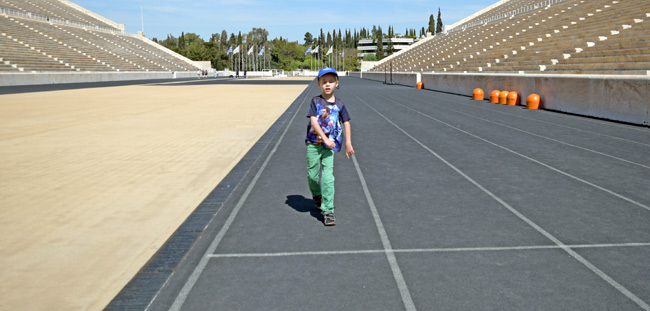The 6-Minute Walk test (6MWT) is designed to test the functional fitness of seniors. It is an adaptation of the Cooper 12-minute run. The 6-Minute Walk test is part of the Senior Fitness Test Protocol. For people who use orthopedic devices when walking, as well as people who have difficulty balancing, there is an alternative 2-minute step in place test.
test purpose: This test measures aerobic fitness
equipment required: measuring tape to mark out the track distances, stopwatch, chairs positioned for resting.
pre-test: Explain the test procedures to the subject. Perform screening of health risks and obtain informed consent. Prepare forms and record basic information such as age, height, body weight, gender, test conditions. Measure and mark out the test area. Perform an appropriate warm-up. See more details of pre-test procedures.
 walking around a track
walking around a trackprocedure: The walking course is laid out in a 50 yard (45.72m) rectangular area (dimensions 45 x 5 yards), with cones placed at regular intervals to indicate distance walked. The aim of this test is to walk as quickly as possible for six minutes to cover as much ground as possible. Participants are set their own pace (a preliminary trail is useful to practice pacing), and are able to stop for a rest if they desire.
scoring: measure the distance walked in 6 minutes to the nearest meter. The following regression equations were determined by Jenkins et al. (2009).
males: Walk Distance (meters) = 867 – (5.71 age, yrs) + (1.03 height, cm)
females: Walk Distance (meters) = 525 – (2.86 age, yrs) + (2.71 height, cm) – (6.22 BMI)
target population: the aged population which may not be able to do traditional fitness tests.
advantages: minimal equipment and costs involved
disadvantages: this test is too easy for the highly fit person. One of the other running tests would be better suited.
other comments: The test should be terminated if the examined person reports dizziness, nausea, excessive fatigue, pain, or if the examiner notices any other symptoms of concern. The examiners should be trained in recognizing these symptoms and the necessary action plan should be in place in case of medical emergencies.
references:
- Rikli R.E., Jones C.J.: The reliability and validity of a 6-minute walk test as a measure of physical endurance in older adults. J of Aging and Physical Activity, 1998; 6: 363–375
- Jenkins S, Cecins N, Camarri B, Williams C, Thompson P, Eastwood P. Regression equations to predict 6 minute walk distance in middle-aged and elderly adults. Physiotherapy Theory and Practice, 25(7):1-7, 2009.
The Test in Action
- The 6 Minute Walk test is part of the Senior Fitness Test Protocol and the Adult Eurofit Protocol
Similar Tests
- See also the alternative 2-minute step in place test
- Procedure for the General Walk / Run test
Related Pages
- Read the Walk / Run Test Review page for a overview of the walk and run tests.
- There is also a 6-minute run test
- More aerobic fitness tests
- Fitness tests involving walking
- Read a discussion about testing the elderly
- All about the Senior Fitness Test
- Read about Fitness Testing for Specific Groups and Special Populations
Related Products
- Buy the Senior Fitness Test Manual


 Current Events
Current Events